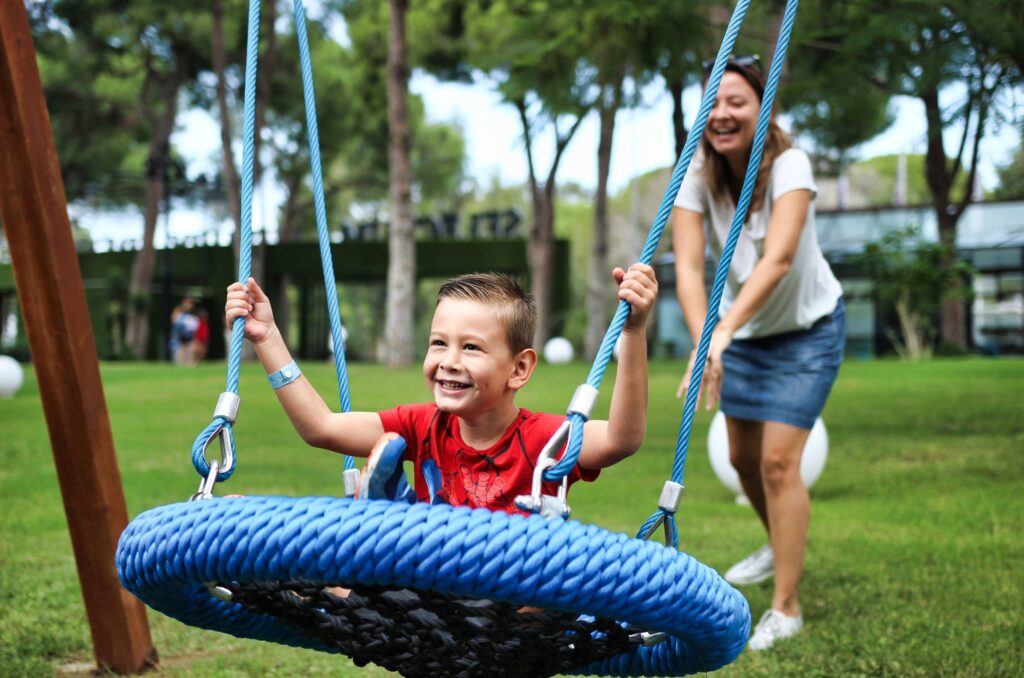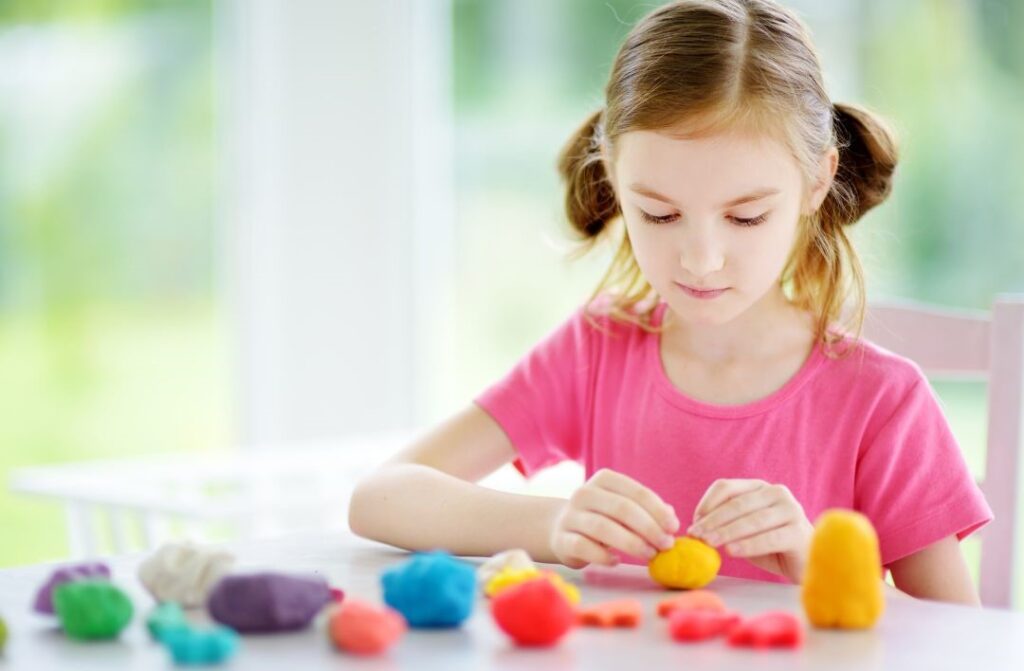How to Create a Sensory Diet for Kids with SPD

Learn how to create a sensory diet for you child-a personalized set of sensory activities designed to meet your child’s unique sensory needs that helps your child stay focused, calm, and balanced.
This post may contain affiliate links and I could earn a small commission at no cost to you. However, I will never recommend anything that I do not believe in or use myself. You can read more about my disclosure policy here.
If you’re here, you’re probably trying to get a better grasp on creating a sensory diet for you child with sensory processing disorder (SPD) or sensory issues.
Maybe you’ve heard about a sensory diet from your child’s therapist or another parent, and you’re curious about how it might help your little one.
Before diving into sensory diets, it might be helpful to check out my posts on sensory processing disorder and sensory play.
Grab a cozy seat and your favorite drink, and let’s explore creating a sensory diet together!
What is a Sensory Diet?
First things first, a sensory diet isn’t about food—although we all love a good snack break!
Instead, it’s a personalized set of sensory activities designed to meet your child’s unique sensory needs. Think of it as a toolkit that helps your child stay focused, calm, and balanced throughout the day.
A sensory diet includes activities that engage the five senses, plus two additional senses related to balance (vestibular) and body awareness (proprioceptive). These activities are chosen based on your child’s specific sensory preferences and needs.
Some kids might need calming activities, while others might benefit from more stimulating inputs. The key is to find the right balance that helps your child feel comfortable and ready to take on the day.
Related: Common Warning Signs Of Sensory Processing Disorder In Kids
Why is a Sensory Diet Important?
Many kids with sensory processing disorder or sensory issues are either overly sensitive (hypersensitive) or under-sensitive (hyposensitive) to certain stimuli. This can make everyday activities challenging.
For example, a child who is hypersensitive to sound might find noisy environments overwhelming, while a child who is hyposensitive to touch might seek out more tactile experiences.
A sensory diet helps balance these sensitivities by providing the right types of sensory input at the right times. This balance can make everyday activities more manageable and enjoyable for your child.
Whether it’s playing, learning, or just hanging out with family, a sensory diet can make a big difference.
Benefits of a Sensory Diet
Improve Focus and Attention
Sensory diets can help kids concentrate better on tasks, whether it’s schoolwork or playtime. By meeting their sensory needs, you can reduce distractions and help them stay engaged.
Reduce Anxiety and Meltdowns
Providing the right sensory input can help prevent overstimulation and the resulting anxiety or meltdowns. It’s like giving your child the tools they need to cope with overwhelming situations.
Enhance Social Interactions
Kids can interact more comfortably and confidently with their peers when their sensory needs are met. This can lead to more positive social experiences and better relationships.
Support Better Sleep
A well-regulated sensory system can lead to improved sleep patterns. When kids get the sensory input they need during the day, they’re more likely to relax and sleep well at night.
Promote Independence
With the right sensory input, kids can become more independent in their daily activities. They’ll feel more capable and confident in managing their sensory needs on their own.

5 Steps to Create a Sensory Diet
Creating a sensory diet can feel a bit overwhelming at first, but with the right approach, it can be an incredibly effective tool for helping your child. Here’s a step-by-step guide to get you started:
Step 1: Understand Your Child’s Sensory Preferences
Every child is unique, especially when it comes to sensory needs. Some kids might seek out sensory input (like hugging tight or jumping) while others might avoid it (like covering their ears at loud noises). Here’s how to start:
Observe Your Child: Watch how they react in different situations. Do they get overwhelmed in noisy places? Do they love spinning or swinging? Take notes! For example, you might notice they always seek out the swings at the park or cover their ears during thunderstorms.
Talk to Your Child: If they’re able to express themselves, ask them what feels good and what doesn’t. You’d be surprised how much they can tell you. Ask questions like, “Do you like it when we play with the slime?” or “How do you feel when we go to the grocery store?”
Consult with Professionals: An occupational therapist (OT) can be a great resource. They can provide insights and even formal assessments. OTs are trained to understand sensory processing and can give you specific strategies tailored to your child’s needs.
Step 2: Identify Sensory Needs
Sensory needs fall into different categories. Here are some to consider:
Proprioceptive Activities
These involve heavy work and deep pressure, like carrying heavy items, bear hugs, or using a weighted blanket. These activities can be calming and help your child feel grounded.
Vestibular Activities
These involve movement, such as swinging, spinning, or jumping. These activities can help regulate your child’s sense of balance and spatial orientation.
Tactile Activities
These involve touch, like playing with sensory bins, finger painting, or cuddling a soft toy. These activities can help your child explore different textures and sensations.
Oral Motor Activities
These involve the mouth, like chewing crunchy snacks or blowing bubbles. These activities can provide calming or alerting input, depending on your child’s needs.
Auditory Activities
These involve sound, like listening to calming music or nature sounds. These activities can help your child manage their sensitivity to noise and find auditory input that is soothing or stimulating.
Visual Activities
These involve sight, like looking at lava lamps, using light-up toys, or watching calming videos. Visual inputs can help children who are visually overstimulated or under-stimulated find a sense of calm or alertness.
Olfactory (Smell) Activities
These involve the sense of smell, such as using scented playdough, essential oils, or baking cookies. Different scents can have calming or alerting effects, helping your child feel more balanced.
Step 3: Create a Sensory Diet Plan
Now that you know your child’s sensory preferences, it’s time to create a plan. Think of this as a daily menu of sensory activities. Here’s a simple template with examples to get you started:
Morning Routine
- Wake-Up Activity: Start with something calming like deep pressure hugs or a quiet time with favorite toys. This helps ease your child into the day without overwhelming them.
- Getting Ready: Use visual schedules or a fun song to guide them through getting dressed. This makes the routine predictable and less stressful.
Mid-Morning
- Active Play: Incorporate movement with a mini-trampoline session or an obstacle course. This helps burn off energy and can improve focus for quieter activities.
- Snack Time: Offer crunchy or chewy snacks like carrots or gummy bears. These types of snacks provide proprioceptive input that can be calming.
Lunchtime
- Calm Down Time: A quiet activity like reading or drawing to wind down. This transition from active play to mealtime helps your child stay regulated.
- Oral Sensory: Try using different flavors and textures during lunch. Incorporate foods that require lots of chewing or offer a variety of tastes.
Afternoon
- Outdoor Play: Engage in activities like swinging, playing in the sandbox, or a nature walk. Fresh air and movement can help reset and energize your child.
- Sensory Bin Fun: Let them explore a sensory bin with rice, beans, or water beads. This provides tactile input and can be both calming and engaging.
Evening
- Wind-Down Routine: Use a weighted blanket, listen to soft music, or have a warm bath. These activities help signal to your child that it’s time to start calming down for bed.
- Bedtime: Stick to a calming bedtime routine, perhaps with some gentle rocking or a bedtime story. Consistency is key to helping your child feel secure and ready for sleep.
Related: Sensory Diet Activities for Kids with Sensory Needs
Step 4: Make It Fun!
Above all, remember that a sensory diet should be fun and engaging. Incorporate activities your child loves and mix in new ones to keep things exciting.
- Never force a child to do these activities: This isn’t just about meeting sensory needs; it’s about creating joyful moments and positive experiences.
- Variety is Key: Keep a mix of activities to prevent boredom. Rotate toys, games, and activities to keep things fresh.
- Family Involvement: Make it a family affair! Parents and siblings can join in on the fun, and it can become a bonding experience for everyone.
- Celebrate Successes: Acknowledge and celebrate when your child finds an activity they love or shows improvement in regulating their sensory needs.
Step 5: Be Flexible and Adjust
A sensory diet is not set in stone. It’s important to be flexible and adjust based on how your child responds. Here’s how to keep it effective:
- Observe and Adjust: If an activity isn’t working, tweak it. Maybe they need more time with a favorite activity or less time with something overwhelming. Pay attention to cues from your child, like if they seem more relaxed or more agitated after an activity.
- Include Your Child: As they grow, involve them in planning their sensory diet. Let them choose activities they enjoy. This empowers them and ensures the activities are engaging.
- Regular Check-Ins: Schedule regular check-ins with your OT to ensure the plan is still meeting your child’s needs. They can offer new strategies or adjustments as your child develops.

Challenging Behaviors Addressed by Sensory Input
Difficulty Focusing
If your child struggles to concentrate, proprioceptive activities like carrying heavy items, doing wall push-ups, or using a weighted blanket can help. These activities provide deep pressure input, which can be calming and help improve focus.
Anxiety and Overwhelm
For kids who get anxious or overwhelmed easily, calming vestibular activities like gentle swinging, rocking in a rocking chair, or slow, rhythmic movements can be soothing. These activities help regulate the vestibular system and provide a sense of security.
Meltdowns and Tantrums
When meltdowns or tantrums occur, providing a calming corner or quiet space with calming tactile inputs like a soft blanket, stuffed animal, or sensory bin with rice or beans can help your child self-soothe. These activities can offer comforting tactile input and help them regain control.
Related: 10 Helpful Strategies to Calm After School Meltdowns
Impulsivity and Hyperactivity
Kids who are constantly on the go might benefit from structured proprioceptive activities like jumping on a trampoline, doing heavy work (like pushing or pulling objects), or engaging in organized sports. These activities help channel their energy in a productive way and provide the sensory input they crave.
Sensitivity to Noise
For children who are hypersensitive to sound, auditory activities like listening to calming music, white noise machines, or noise-canceling headphones can help manage their sensitivity. These activities provide soothing auditory input and help reduce anxiety in noisy environments.
Avoidance of Touch
If your child is sensitive to touch, start with less intrusive tactile activities like playing with playdough, kinetic sand, or engaging in water play. Gradually introducing these activities can help them become more comfortable with different textures.
Difficulty with Transitions
Transitions can be tough for many kids. Visual schedules, timers, and proprioceptive activities like deep pressure hugs or carrying a heavy backpack can help them prepare for changes in routine. These strategies provide sensory input that can ease the anxiety associated with transitions.
Related: How to Help an Autistic Child with Transitions Between Activities
Final Thoughts
Every child is unique, and what works for one might not work for another. Be patient and persistent, and don’t hesitate to seek help from professionals or support groups.
You’re doing an incredible job supporting your child’s journey. A sensory diet might be just the tool you need to help them thrive.
Have any questions or tips of your own? Share them in the comments below. We’re all in this together!
Recommended
- Sensory Diet Activities for Kids with Sensory Needs
- Common Warning Signs Of Sensory Processing Disorder In Kids
- Why Sensory Play Is Important For Child Development
- How to Help an Autistic Child with Transitions Between Activities
- 10 Helpful Strategies to Calm After School Meltdowns
- Ultimate Toy Guide: 30 Best Sensory Toys for Autistic Children






